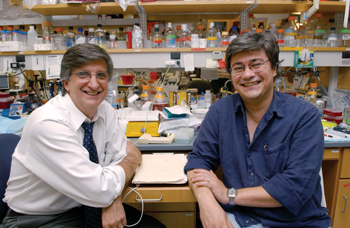
Pat Levitt, Ph.D., left, and Alexandre Bonnin, Ph.D., are working to understand the role of serotonin in embryonic brain development. (photo by Susan Urmy)
Serotonin’s role in brain development investigated
The tentacle-like projections of brain cells find their way to their final destination by following chemical cues. If something interferes with these cues, the consequent “miswiring” could lead to a number of neuropsychiatric disorders.
In the May issue of Nature Neuroscience, Pat Levitt, Ph.D., director of the Vanderbilt Kennedy Center for Research on Human Development, and colleagues describe how disrupted serotonin signaling in the developing mouse brain may lead nerve cells astray — setting up a disorganized brain architecture that may underlie psychiatric conditions like autism, depression and schizophrenia.
“Our goal was to understand the role of serotonin in embryonic brain development,” said Alexandre Bonnin, Ph.D., postdoctoral fellow in Pharmacology and lead author on the paper. “In a previous study where we mapped the expression of serotonin receptors in the embryonic brain, we observed some very interesting and unexpected patterns.”
In this earlier study, they detected very strong expression of serotonin receptors in a central part of the brain called the thalamus, which acts as the brain's “switchboard” for sensory information. The thalamus relays incoming sensory information from the periphery to the brain's outermost layer, the cortex.
“Based on this expression pattern, we wondered what serotonin was doing,” Bonnin said. “The most probable role at this stage of development was to be involved in circuit formation, or axon guidance mechanisms.”
Serotonin was known to play a role in the postnatal development of this “thalamocortical” circuit, but no one had yet determined a role for the neurotransmitter so early in brain development.
To investigate, Bonnin, Levitt and colleagues cultured cells from the thalamus of mouse embryos with cells that expressed netrin-1. They found that thalamic axons — the long thin projections from the nerve cell body — were normally attracted by netrin-1, but this response was switched when they exposed the cells to serotonin.
Bonnin and colleagues then tested these findings in live mouse embryos. In a painstaking in utero surgery, the researchers inserted bits of DNA into one side of the developing mouse brain. These DNA fragments either increased or decreased the expression of serotonin receptors in the developing thalamus.
When they observed the brains a few days after the procedure, they found that the axons on the unaltered side of the brain followed a normal path. On the side with altered expression of serotonin receptors, the paths of thalamocortical axons were shifted slightly.
Bonnin hopes to determine whether this subtle disruption in pathfinding leads to an overall change in the architecture of the somatosensory areas of the cortex, which might set the stage for disorders like depression and autism.
The results demonstrate a new role for serotonin in regulating the development of sensory connections in the brain, but many questions remain, particularly about the source of serotonin in the developing brain.
Serotonin-producing brain cells begin forming very early, but recent evidence suggests that the mother serves as an important source of the neurochemical. Therefore, factors that alter serotonin levels in the mother — such as antidepressants, low tryptophan diets, and even genetic variations — could subtly affect the developing brain.
Although this study suggests a possible link between altered serotonin signaling and neuropsychiatric disorders, Bonnin noted that much more study is needed.
“In the human brain, it's hard to study this, but the technology has improved. I hope that researchers will begin to look at circuit formation more precisely.”
Other authors were Masaaki Torii, Ph.D., and Lily Wang, Ph.D., from Vanderbilt and Pasko Rakic, M.D., Ph.D., at Yale University Medical School. The study was supported by grants from the National Institutes of Health.













